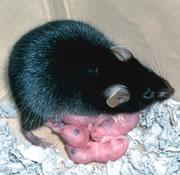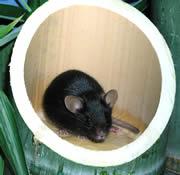 Kaguya is one sucess from 460 attempts at growing embryos.© T. Kono
Kaguya is one sucess from 460 attempts at growing embryos.© T. KonoFromtime immemorial, making a mammalian baby has involved two essential ingredients: eggs and sperm. Now Japanese scientists have written men out of the reproduction rule-book, and created fatherless mice.
The team made the animals by combining the nucleus of one female's egg with that of another, essentially creating a mouse with two mothers. "It is a bit of a surprise," says evolutionary biologist David Haig of Harvard University, Boston.
After nearly 460 attempts at growing embryos, ten live pups were born and just one of those survived to adulthood. Christened Kaguya, from the story of a girl discovered in a bamboo stump, the mouse is now 14 months old and has babies of her own. She is "very healthy", says team leader Tomohiro Kono of Tokyo University of Agriculture.
Some might say that Kaguya is living proof of men's futility, in the baby-making stakes at least. But scientists maintain it is premature for chaps to step aside in human reproduction: there are significant obstacles to transferring the technique to the fertility clinic.
Like human reproductive cloning, which is thought unsafe, it is not known whether the animals produced are entirely healthy and normal. The technique is also hugely laborious, has a high failure rate and would involve genetically engineering a human egg, which is generally considered to be ethically unacceptable.
<mediar rid='m2'/>"Thepopular press will say that men are redundant," predicts developmental biologist Azim Surani of the University of Cambridge, UK. "But what the researchers did is not straightforward."
Men not included
The process by which a female's egg is triggered to grow without fertilization is called parthenogenesis. Although plants, some fish, frogs, insects and occasionally chickens can all procreate without a partner, until now most mammalian embryos created this way have died halfway through pregnancy.
This is thought to be because mammalian embryos need the correct combination of genetic material from mother and father in order to survive and grow. Although eggs and sperm carry equivalent sets of genes, they are stamped with different patterns of gene activity called imprints, meaning that certain genes are working in eggs and silent in sperm, and the other way around.
Other researchers have attempted to bypass imprinting and kick-start parthenogenesis by pricking, shocking or chemically jolting mouse eggs, without success. But Kono and his colleagues tried a more subtle approach, effectively metamorphosing a female egg into a surrogate sperm, they report in this week's Nature1 .
 Kaguya shows that imprinting normally blocks parthenogenesis.© T. Kono
Kaguya shows that imprinting normally blocks parthenogenesis.© T. KonoTheresearchers started with an immature, female egg whose genes had not yet been stamped with an imprint. They took the egg from a mouse genetically engineered to lack both a gene known as H19, which is normally subject to imprinting, and a region that would otherwise switch off a gene called Igf2. The two genes are thought to control foetal growth.
Kono believes that these steps endowed the egg with a pattern of gene activity similar to that of a sperm. They fused this sperm-like egg with another, mature egg from a different female. By analysing over 1000 genes in the resulting animals, they found that the mice appeared to be genetically relatively normal.
Experts say the study provides definitive evidence that it is imprinting that normally blocks parthenogenesis. The process may have evolved in males to ensure that reproduction cannot occur without their genetic input, Kono proposes.
Whether or not this is true, the technique should help researchers analyse the imprinting process in order to work out how it controls embryo growth and what happens when it goes awry. As for Kono, he is already working on relieving another species of its partner: "The next target is the pig," he says.
